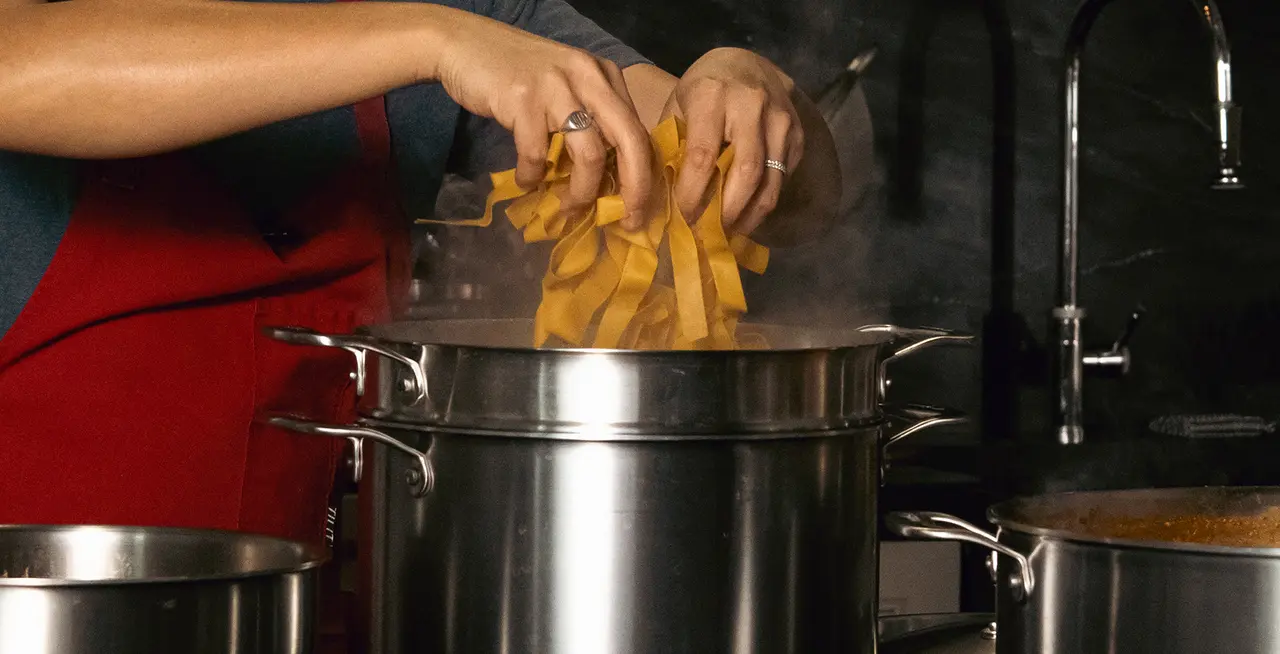At Made In, we aim to break down the barrier between professional kitchens and home kitchens by offering cookware and tools that will have you cooking like an executive chef. Beyond cookware, we also want to teach you techniques and tricks to make you a better home cook. We’ve already taught you how to plate like a chef, and now we’re here to teach you how to cook pasta perfectly. There are a few tips and tricks, but once you get the hang of it, you’ll never order pasta at a restaurant again! In this post, we’re going to talk about:
- Pasta Water
- Cooking the Pasta
- Marrying the Pasta with the Sauce
- Plating the Pasta
Salt Your Pasta Water
It might not seem like an important step or one that can be messed up, but pasta water can make or break your dish. There’s a reason the salted water is referred to as “liquid gold”! There are two main things that make pasta water such a critical part of your dish: starch and salt. Salting your water is the only chance you have to impart flavor onto your pasta. Salt the water more than you think. How much? I’ll let you decide how much you like to add based on your taste, but I’m a firm believer that you should add way too much salt at least once, so you can gauge how much it takes to get it right. A good guideline? When you add salt to the water, give it a taste. It should taste like something.
The next essential aspect of the pasta water is the starch component. When the pasta cooks, it will release starch into the water, which is a natural thickening agent. Why is this necessary? When you add your pasta to the sauce (which we will get to later), you will also add some of the starchy pasta water. This will help thicken the sauce and create a cohesive marriage between the sauce and the pasta. Yes, days of topping your pasta with sauce are over. A key to maximizing your pasta water’s starch component is not to use a lot of water when you boil pasta. Yes, filling up a large pot with 8 quarts of water is common, but not always necessary if you’re cooking pasta for 2-3 people. I love using a 4 QT Saucepan, as I find it has enough space for a pound of pasta to cook while also making sure the pasta water is rich with salt and starch, contributing to my sauce. Bring the water to a boil, add your pasta, give it a stir. Let’s move on.
Al Dente is King
This is quite simple. Your pasta should not be cooked 100% of the way in the boiling water. 80% in the water, 20% in the sauce is a good rule to follow. Follow the package instructions, so if it says it takes 12 minutes to cook, cook it for nine and then try it. If it still has a bite, then it’s done. If it’s tacky, cook it for longer. Remember that you can always cook the pasta longer in the sauce. If it’s overcooked and mushy, there’s nothing you can do about it.
This where the magic happens. Your pasta should be cooked 80% of the way, so we need to cook it the rest of the way in our sauce. I highly recommend combining the pasta with the sauce in a separate frying pan or saucier. Anything with a sloped lip or high walls is ideal, as movement is critical. You can add the pasta to your sauce by either using a handheld strainer or a colander. If you use the handheld strainer, then you’re able to keep all the salty, starchy pasta water. If you drain the pasta through a colander, make sure to reserve 2 cups of pasta water. Will you need all of that? Most likely, no. But it’s going down the drain anyway, so you may as well save a lot just in case.
The Marriage of Sauce and Pasta
With your sauce on medium heat, add your pasta to your sauce, along with a ladle, or ½ cup, of your pasta water. Since the pasta water was boiling, it will continue to cook the pasta and “marry” the pasta to the sauce. As you bring the salty, starchy pasta water to your sauce, along with the pasta, allow it to cook. Don’t add too much pasta water, as you can risk having a too watery sauce. Once your pasta sauce has thickened and you are happy with the ratio of pasta to the sauce, turn the heat off. The next step is optional, but I highly recommend it. Off heat, toss your pasta with a few knobs of butter and some finely grated cheese (I omit the cheese if the sauce is oil-based). The end result should be a glossy sauce that sticks to the pasta. And most importantly, it should taste rich and be memorable.
How to Plate
To elevate your meal, serve your pasta in warm bowls, as this will keep the pasta hotter for longer. If your bowls are oven-safe, set your oven to its lowest temperature and place the bowls in there. If your bowls aren’t oven-safe, then you can fill them with hot water or put them in a warming drawer. When it comes to plating your pasta, try and plate it as high as possible, so the heat is retained throughout the dish. Finish with a drizzle of olive oil and some more freshly grated cheese, as well.
Now, if you have leftover pasta, which should never be the case, you can always turn it into a pasta salad. And no, don’t douse it with mayo and carrots and celery. Some pesto, sliced cherry tomatoes, and balls of mozzarella are a lot better. You can also turn leftover pasta into a frittata, which I highly recommend and a great way to turn one great meal into another.
Whether it’s fresh pasta or dried pasta, you deserve to have the best meal of your life. Remember the tips and tricks laid out above, and you will be crafting pasta like a professional. And please keep the following in your mind: never wash your pasta under cold water, don’t precook your pasta, and please never use angel hair.
























